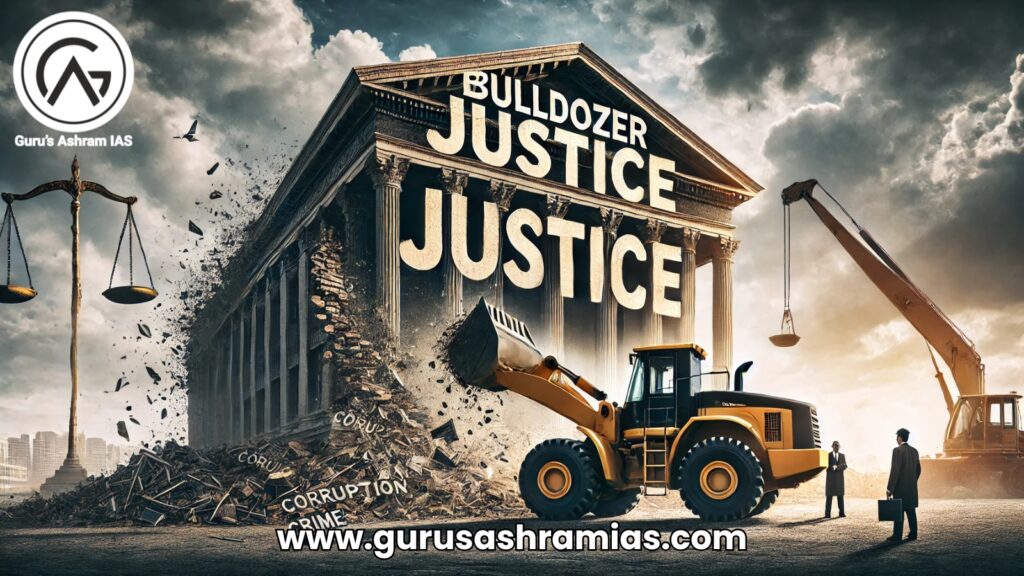Bulldozer Justice
- On 13 November 2024, a bench of Justices B. R. Gavai and K. V. Viswanathan of the Supreme Court delivered a significant judgment, criticizing the “bulldozer justice” over the matter of illegal demolition.
- The judgment raised serious questions on the practice of punitive destruction of property of persons involved in crimes by the State Governments. It is being considered a historic decision, which is important to protect the basic rights of the citizens.
Bulldozer Justice:
- In India, “Bulldozer Justice” is a controversial and debated practice in which the property of persons involved in crimes, such as illegal construction or other crimes, is demolished by the authorities with bulldozers and heavy machinery. This is often done without following legal procedure and without any judicial order.
Background:
Tibrewal Akash case:
- The practice came into the limelight after a case in 2019, when journalist Manoj Tibrewal’s ancestral property in Uttar Pradesh was demolished. The authorities had done it for the expansion of the national highway, but the court found that there were several violations in the process.
- The authorities demolished the land without issuing written notices and more than the prescribed limit. The action was taken after the journalist’s father demanded a probe into the irregularities in the road project, leading to it being seen as a retaliatory move.
- The National Human Rights Commission (NHRC) found that the demolition was overzealous. According to the commission, while only 3.7 m of land was encroached upon, the authorities demolished up to 5 to 8m of land.
Arguments in favor of Bulldozer Justice:
- Bulldozer justice is seen by some as a measure to prevent crimes and maintain law and order in society. Such as:
Preventing Crimes:
- Proponents believe that illegal construction or demolition of properties associated with crimes can lead to control of criminal activities in the society. This can be a strong message to others about the consequences of violating the law.
Quick action:
- Some people consider it a fast and effective way, allowing illegal constructions to be removed immediately. Such cases can be delayed by prolonged judicial process, while immediate action is required.
Public sentiment and realisation of justice:
- It is also argued that bulldozer justice instills confidence in the people as an immediate and robust system of justice, especially in cases where the judicial process takes time and criminals escape punishment.
Strict measures by the government:
- Some people consider it as a strict and quick step on the part of the state government to control criminals and illegal activities. They feel that this can lead to faster resolution of corruption and bad habits. This will instill fear in the minds of criminals.
Speedy removal of illegal constructions:
- Proponents also believe that action against illegal constructions and encroachments in cities and metros is extremely necessary. This type of action leads to the correct use of land and prevents the disorganization of cities. The demolition of illegal buildings will also ensure the safety of the people.
Supreme Court Guidelines on Bulldozer Justice:
Issue notice:
- At least 15 days’ notice should be given to the property owner before any kind of demolition.
- The notice should clearly state the details of the structure to be demolished and the reasons for demolition.
Fair hearing:
- Allocate time for individual hearings so that the affected party has an opportunity to oppose the demolition or explain the situation.
Transparency:
- Authorities will have to inform the local collector or district magistrate through e-mail after sending the notice.
The final order:
- The final order should include the arguments of the property owner, the justification of the authority to consider demolition as the only option and whether the entire structure or the partial structure is to be demolished.
Period after final order:
- If a demolition order is issued, 15 days should be given before its execution to give the property owner an opportunity to remove the structure or challenge the order in court.
Documentation of demolition:
- The authority will have to video record the demolition and prepare an “inspection report” in advance, as well as a “demolition report” listing the personnel involved.
Test for double violation:
- The Supreme Court has prescribed a separate test for cases where the demolished property is the residence of an accused and there is a violation of municipal laws by that property in the form of illegal construction.
- The Supreme Court said that if only one structure is demolished while similar structures are left untouched, it could mean that the purpose is to punish the accused and not to remove the illegal construction.
Exceptions:
- The Supreme Court clarified that its directions shall not apply in cases where there is any unauthorised structure in a public place like a road, lane or footpath, near a railway line or a river or water body and in cases where demolition has been ordered by the Court.
Bulldozer justice is a matter of concern:
Increase in punitive damages:
- The Housing and Land Rights Network (HLRN) estimate for 2024 found that authorities demolished 153,820 homes in 2022 and 2023, displacing more than 738,438 people in rural and urban areas.
The International Covenant on Civil and Political Rights (ICCPR):
- Article 17 of the International Covenant on Civil and Political Rights (ICCPR) states that everyone has the right to own property, individually or in association with others, and that no one shall be arbitrarily deprived of his or her property.
Collective punishment:
- The Supreme Court observed that the demolition drive not only targets the alleged perpetrators of the crime but also imposes a kind of “collective punishment” on their families by destroying their place of residence.
Speedy justice:
- Vandalism has been justified as an action against encroachment or unauthorised construction. Such state-sanctioned acts of punitive violence have been hailed as “speedy justice.”
Criticism of ‘Bulldozer Justice’:
- The Supreme Court in this judgment reviewed several important legal principles and expressed serious concerns against Bulldozer Justice. These are as follows –
Rule of Law:
- The Court pointed out that the State is also mandated to follow the law. Destroying someone’s property without due process of law is a violation of the principles of democracy and justice. If this happens, it will erode people’s faith in constitutional institutions.
Concept of innocence of the offender:
- The Court also observed that the destruction of property of a person without convicting him is a violation of the concept of innocence.
Right to shelter:
- The court also made it clear that the right to shelter is part of human dignity, and one cannot be deprived of this right without due legal process. This is part of the fundamental rights under Article 21.
Abuse of Power:
- The Court also observed that in some cases, bulldozer justice can be a form of abuse of power in which discriminatory action is taken against a particular person or community. This can increase the feeling of separatism in the minds of a particular community.
Creation of fear in the society:
- The Court also observed that such prompt actions can create an atmosphere of fear and insecurity in the society, which weakens the sense of justice.
Measures to avoid delay of justice:
- Although the Court acknowledged the problem of delay in the process of justice, it also said that the judicial process should be improved and speeded up instead of bulldozing justice to deal with it.
Absence of evidence and proof:
- The Court also held that in cases of illegal demolitions, it is imperative that the authorities have proper evidence and proof, and any action without this should be prohibited.
Solution:
Upholding the rule of law:
- All state actions must be in strict compliance with the law. The legal system must distinguish between criminal justice and collective punishment, ensuring that the presumption of innocence prevails.
Enhancing Judicial Oversight:
- Special tribunals should be set up to exclusively deal with disputes relating to the demolition of property, with powers to review government decisions.
Alternative dispute resolution:
- Mechanisms such as mediation and arbitration should be actively promoted as an effective way to resolve disputes related to property rights and demolition.
Recovery plans:
- It is important to formulate detailed rehabilitation plans for persons affected by the demolition, including provision of alternative housing, livelihood support and access to mental health services.
Note:
Article 142:
- Article 142 of the Constitution empowers the Supreme Court to pass orders and decrees necessary for complete justice in any case.
- Article 142 (1) empowers the Supreme Court to pass orders enforceable throughout India (as determined by the President) to do complete justice.
- Article 142 (2) empowers the court to ensure attendance, search documents or impose punishment for contempt.
- Over time, this provision has been used to ensure “complete justice” and to plug legislative loopholes.




